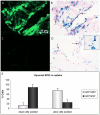Clinically translatable cell tracking and quantification by MRI in cartilage repair using superparamagnetic iron oxides
- PMID: 21373640
- PMCID: PMC3044153
- DOI: 10.1371/journal.pone.0017001
Clinically translatable cell tracking and quantification by MRI in cartilage repair using superparamagnetic iron oxides
Abstract
Background: Articular cartilage has very limited intrinsic regenerative capacity, making cell-based therapy a tempting approach for cartilage repair. Cell tracking can be a major step towards unraveling and improving the repair process of these therapies. We studied superparamagnetic iron oxides (SPIO) for labeling human bone marrow-derived mesenchymal stem cells (hBMSCs) regarding effectivity, cell viability, long term metabolic cell activity, chondrogenic differentiation and hBMSC secretion profile. We additionally examined the capacity of synovial cells to endocytose SPIO from dead, labeled cells, together with the use of magnetic resonance imaging (MRI) for intra-articular visualization and quantification of SPIO labeled cells.
Methodology/prinicipal findings: Efficacy and various safety aspects of SPIO cell labeling were determined using appropriate assays. Synovial SPIO re-uptake was investigated in vitro by co-labeling cells with SPIO and green fluorescent protein (GFP). MRI experiments were performed on a clinical 3.0T MRI scanner. Two cell-based cartilage repair techniques were mimicked for evaluating MRI traceability of labeled cells: intra-articular cell injection and cell implantation in cartilage defects. Cells were applied ex vivo or in vitro in an intra-articular environment and immediately scanned. SPIO labeling was effective and did not impair any of the studied safety aspects, including hBMSC secretion profile. SPIO from dead, labeled cells could be taken up by synovial cells. Both injected and implanted SPIO-labeled cells could accurately be visualized by MRI in a clinically relevant sized joint model using clinically applied cell doses. Finally, we quantified the amount of labeled cells seeded in cartilage defects using MR-based relaxometry.
Conclusions: SPIO labeling appears to be safe without influencing cell behavior. SPIO labeled cells can be visualized in an intra-articular environment and quantified when seeded in cartilage defects.
Conflict of interest statement
Figures





Similar articles
-
In vivo MR imaging tracking of magnetic iron oxide nanoparticle labeled, engineered, autologous bone marrow mesenchymal stem cells following intra-articular injection.Joint Bone Spine. 2008 Jul;75(4):432-8. doi: 10.1016/j.jbspin.2007.09.013. Epub 2008 May 2. Joint Bone Spine. 2008. PMID: 18448377
-
[In vivo MR imaging tracking of supermagnetic iron-oxide nanoparticle-labeled bone marrow mesenchymal stem cells injected into intra-articular space of knee joints: experiment with rabbit].Zhonghua Yi Xue Za Zhi. 2007 Dec 4;87(45):3213-8. Zhonghua Yi Xue Za Zhi. 2007. PMID: 18399117 Chinese.
-
In vitro targeted magnetic delivery and tracking of superparamagnetic iron oxide particles labeled stem cells for articular cartilage defect repair.J Huazhong Univ Sci Technolog Med Sci. 2011 Apr;31(2):204-209. doi: 10.1007/s11596-011-0253-2. Epub 2011 Apr 20. J Huazhong Univ Sci Technolog Med Sci. 2011. PMID: 21505986
-
Amine-modified silica-coated polyhedral superparamagnetic iron oxide nanoparticle–labeled rabbit bone marrow–derived mesenchymal stem cells.2009 Dec 11 [updated 2010 Jan 28]. In: Molecular Imaging and Contrast Agent Database (MICAD) [Internet]. Bethesda (MD): National Center for Biotechnology Information (US); 2004–2013. 2009 Dec 11 [updated 2010 Jan 28]. In: Molecular Imaging and Contrast Agent Database (MICAD) [Internet]. Bethesda (MD): National Center for Biotechnology Information (US); 2004–2013. PMID: 20641854 Free Books & Documents. Review.
-
FluidMAG iron nanoparticle-labeled mesenchymal stem cells for tracking cell homing to tumors.2009 Dec 23 [updated 2010 Feb 16]. In: Molecular Imaging and Contrast Agent Database (MICAD) [Internet]. Bethesda (MD): National Center for Biotechnology Information (US); 2004–2013. 2009 Dec 23 [updated 2010 Feb 16]. In: Molecular Imaging and Contrast Agent Database (MICAD) [Internet]. Bethesda (MD): National Center for Biotechnology Information (US); 2004–2013. PMID: 20641467 Free Books & Documents. Review.
Cited by
-
Quantitative MRI of articular cartilage and its clinical applications.J Magn Reson Imaging. 2013 Nov;38(5):991-1008. doi: 10.1002/jmri.24313. Epub 2013 Oct 2. J Magn Reson Imaging. 2013. PMID: 24115571 Free PMC article. Review.
-
Viability, differentiation capacity, and detectability of super-paramagnetic iron oxide-labeled muscle precursor cells for magnetic-resonance imaging.Tissue Eng Part C Methods. 2015 Feb;21(2):182-91. doi: 10.1089/ten.TEC.2014.0110. Epub 2014 Aug 4. Tissue Eng Part C Methods. 2015. PMID: 24988198 Free PMC article.
-
Effect of labeling with iron oxide particles or nanodiamonds on the functionality of adipose-derived mesenchymal stem cells.PLoS One. 2013;8(1):e52997. doi: 10.1371/journal.pone.0052997. Epub 2013 Jan 3. PLoS One. 2013. PMID: 23301012 Free PMC article.
-
A Translational Porcine Model for Human Cell-Based Therapies in the Treatment of Posttraumatic Osteoarthritis After Anterior Cruciate Ligament Injury.Am J Sports Med. 2020 Oct;48(12):3002-3012. doi: 10.1177/0363546520952353. Epub 2020 Sep 14. Am J Sports Med. 2020. PMID: 32924528 Free PMC article.
-
Human conditionally immortalized neural stem cells improve locomotor function after spinal cord injury in the rat.Stem Cell Res Ther. 2013 Jun 7;4(3):68. doi: 10.1186/scrt219. Stem Cell Res Ther. 2013. PMID: 23759119 Free PMC article.
References
-
- Brittberg M, Lindahl A, Nilsson A, Ohlsson C, Isaksson O, et al. Treatment of deep cartilage defects in the knee with autologous chondrocyte transplantation. N Engl J Med. 1994;331:889–895. - PubMed
-
- Centeno CJ, Schultz JR, Cheever M, Robinson B, Freeman M, et al. Safety and complications reporting on the re-implantation of culture-expanded mesenchymal stem cells using autologous platelet lysate technique. Curr Stem Cell Res Ther. 2010;5:81–93. - PubMed
-
- Wakitani S, Nawata M, Tensho K, Okabe T, Machida H, et al. Repair of articular cartilage defects in the patello-femoral joint with autologous bone marrow mesenchymal cell transplantation: three case reports involving nine defects in five knees. J Tissue Eng Regen Med. 2007;1:74–79. - PubMed
Publication types
MeSH terms
Substances
LinkOut - more resources
Full Text Sources
Other Literature Sources
Medical

